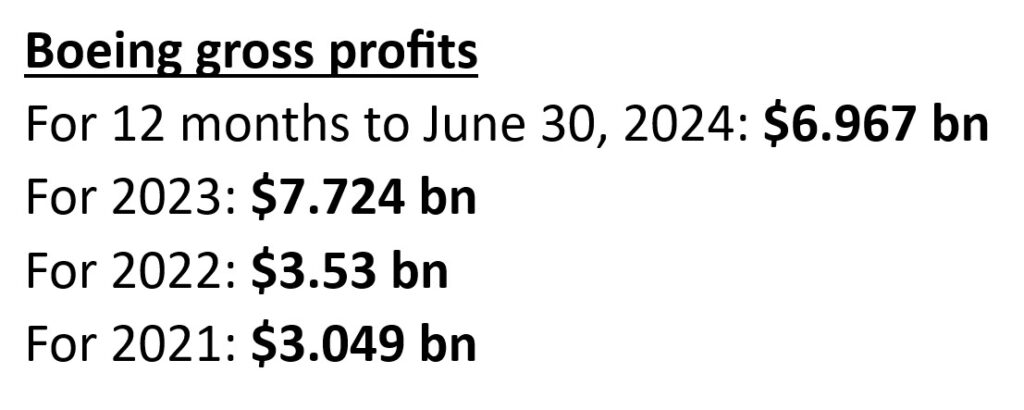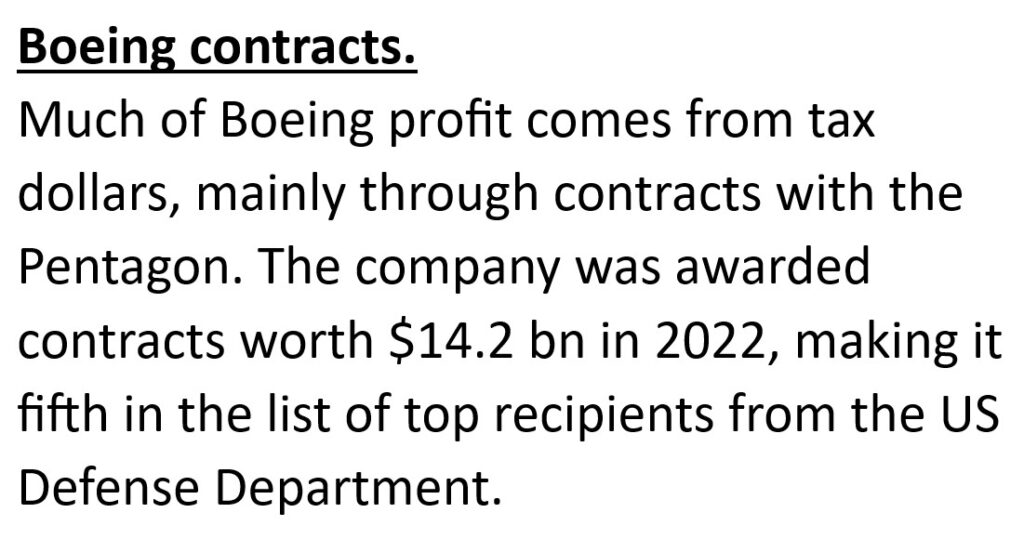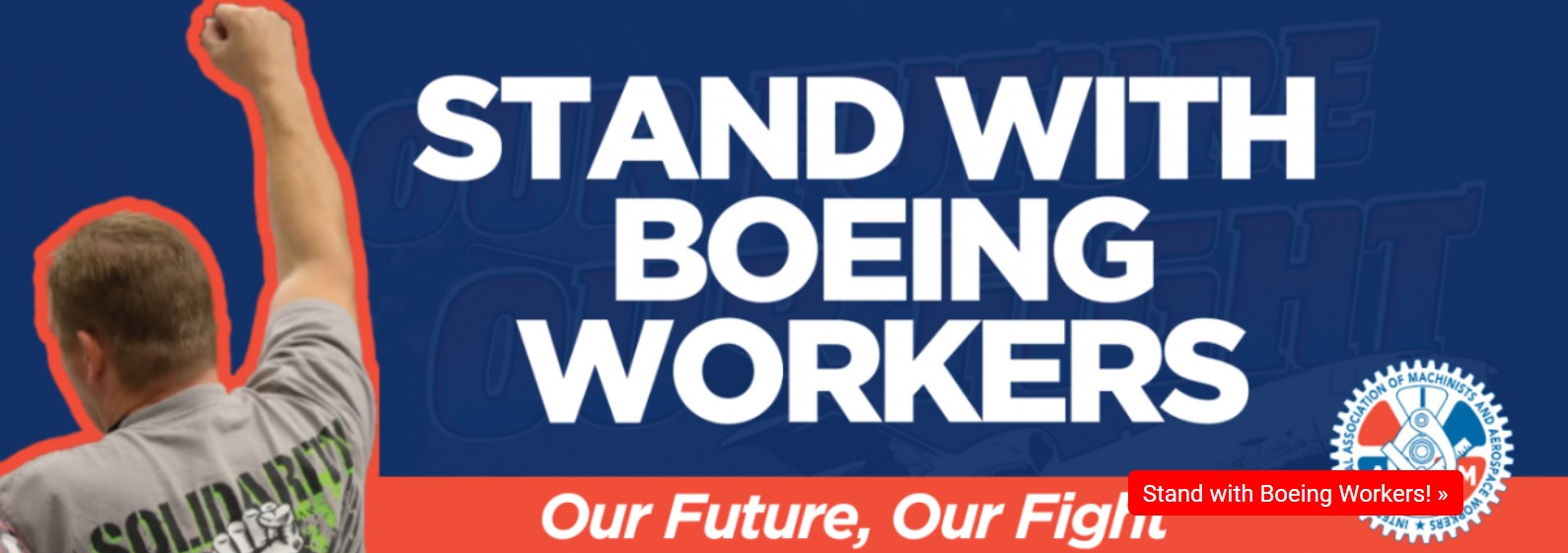By Richard Mellor in California
The strike at Boeing by 33,000 members of the International Association of Machinists and Aerospace Workers (IAM) District 75 is in its second week. [See previous post]. In a negotiation session earlier this week, the company put its “best and final” offer on the table with a two day deadline for a response.
The IAM negotiators have refused to take it to the members claiming the proposal had been “thrown at us without any discussion”. This isaccording to the US Guardian.
Given that it was suggested by one reader that I am too much of a pessimist and always assume the worst, I will stress that I want more than anything for the Boeing workers to win and to win big. It benefits all of us when workers on strike walk away with significant gains.
However I am not a dreamer. I have to look at the situation for what it is and also my opinions are a product of objective reality over a long period of time. So far, I see a very similar pattern developing and similar phraseology coming from the union hierarchy that does not give me confidence that this strike will be managed any differently than thousands of disputes before it.
In October 2017, workers, members of the IAM, at the Henkel Aerospace Industrial in Bay Point, a working class town in the East SF Bay Area, were forced out on strike by their employer. Bosses often choose to go on the offensive around Christmas time, as it places a lot of added pressure on workers and our families.
“We’re fighting for the next generation”
I went out to walk the picket lines with them and find out a bit more about the issues. I wrote back then: “When I went to this IAM picket yesterday I saw a similar situation. There was a strong mood of solidarity and workers were positive and upbeat in the sense that they were standing up to the boss”
“’We’re fighting for the next generation’ one striker told me. But they were all standing around as trucks and equipment, as well as other workers entered freely. They told me they were picketing in front of the entrance for a while walking slowly across it as we used to do, but the bosses’ complained and the union officials told them to stop. If they continued to do it, the cops will come and the union will be in trouble”.
The picketers had a rat design on the picket signs, “Show the boss that rat”. That’ll scare the boss in to submission won’t it? It’s embarrassing that is. Part of the union leadership’s strategy for years has to bring big inflatable rats to picket lines. How can a strike be won this way? This was December 13 and the workers had been out for about 12 weeks at that time, right before Christmas.
We have to violate anti-union laws
One striker asked me if I thought the strike could win and I had to be honest that it could, but not unless they shut this place down and reached out to other unions and the community, and we have to recognize that we will have to violate anti-union laws like the one that allows the bosses to hire scabs permanently in an economic strike.
But we can only do this in a mass way and that is why we cannot allow strikes by individual unions to be fought in isolation from the rest of the labour movement and the working class as a whole. I then told them their local union belonged to the Contra Costa Labor Council, (CCLC) in fact the head of that council was an IAM official. I said that Contra Costa Council has about 80,000 members affiliated to in the county.
I should add here that there was one worker who knew what the CCLC was, as a call was made to the council, and they brought the phone to me. I asked who it was and it was Steve Holder, the head of the CCLC, an IAM member himself. He asked who I was and I was polite saying I was there in solidarity and a retired Afscme member.
He said he just wanted to be sure not just anyone talks to the media as it can be confusing and the union’s line could be misinterpreted, or words to that effect. The officials are very concerned that militant and angry workers may get their voices heard in the media.
Strikebreakers enter the plant protected by police
I asked Holder why the strike was called an “unfair labor practice” strike and he said it couldn’t be an economic strike because then the bosses can hire the scabs working inside permanently by law. The bosses and already hired unemployed or low waged workers to break the strike*.

Pulled off the job and onto the sidewalk over an obscure issue like the boss being “unfair”, with the only advantage getting free coffee and donuts, while vehicles enter the plant under the protection of the police and strike breakers work inside, does not make the workers sacrifice and dedication for a better life stronger. Often, the unfair labour practice in these cases is the boss treating the negotiators with contempt at the negotiating table.
However, most of the workers I spoke to had no idea they were affiliated to the CCLC or what it was. On hearing this, one striker says to me emphatically, “Well why aren’t they here?” That’s a great question I told him. Pessimist that I am, I explained why, an explanation, I believe, is the correct one, so I won’t repeat all of it here.
Mobilising other union workers means confrontation
For the leadership in the higher bodies and the AFL-CIO in general, to mobilize those 80,000 members, and the IAM members in neighboring counties and shut production at this plant, would mean a confrontation with the police, the courts, the judges, the mass media and other allies of the employers in society. Of course, with the stick will come the carrot, the wolves in sheeps’ clothing, in the form of local Democratic Party politicians getting a photo-op and calling for a “fair” agreement.
In this case, Henkel Aerospace Industrial made parts for Boeing, I believe, and I brought this point up to the workers on the line and none of them disagreed with it. But they know the consequences can be dire when we go on the offensive and don’t stick to the rules accepted by the trade union hierarchy and their allies in the Democratic Party: unemployment, loss of medical benefits, loss of one’s home. As I pointed out in my earlier comment on the Boeing strike, “Washington, Oregon and California residents are among the nations most indebted, with the average Washington residentin debt to the tune of $180,000 according to Experien,.”
So workers fears and caution are justified, and we do not go on strike easily, as the mass media claims. The term “strike happy” should be struck from the daily usage just as the “N” word is today. No worker is “happy” to risk their livelihood and family welfare, and a strike is literally a last resort.
Back to the Boeing strike. The media reports that last week, “….workers brought along a portable charcoal barbecue and a poster with the cartoon likeness of Boeing’s former CEO Dave Calhoun grinning and carrying away stacks of $100 bills. “WE MAKE THEM BILLIONS THEY GIVE EACH OTHER MILLIONS,” it read.”
Well-worn tactics…that don’t work
This is not a tactic that sprung from intense discussion and debate among the union’s rank and file on what they need to do to win. It’s a well-worn tactic developed from above to shame the bosses. It hasn’t worked, by the way.
The president of IAM District 751 in Washington points out that the union leadership originally recommended the contract, because “we couldn’t get any more (at the table) and this was all we could negotiate short of a strike”, adding that, “We have to turn it over to the real power, which is our membership, and they took it from there, so I’m proud of them”.
That the membership is the real power is correct, but why would you take a contract to the membership, that you knew they would reject, unless you didn’t have an alternative plan? It’s dishonest to phrase it this way. The reality is the leadership supported the contract against the wishes of the membership, which were widely known.
Myself and two other members of our team in 1997 found ourselves in the same position. After months of negotiations, we agreed to take a contract to the members for a vote. The three of us did not support the contract and believed we could get more, but not at the table. So we recommended a “no” vote.
Given the situation and the relatively good conditions we had, compared to most workers in the US, we figured the members would accept, and three others and the Business Agent spoke in favour of the deal, but we were honest with them.
We discussed among ourselves that we could not recommend a ‘no’ vote and simply leave it there. I recall telling many of my co-workers, “I am supporting a “no” vote on the contract but you can’t vote no and go fishing.” We have a plan, and if you get involved in it we can win more.
A solidarity committee was formed
During all the time we were in negotiations, we had a strategy of building allies in the community, our sister union, also Afscme that represented the white collar workers, and other unions in the area. We had a number of co-workers that were active in a solidarity committee we formed and we produced fliers for the unemployment office, (we had a demand for more jobs on the table) the welfare offices, and fliers that were left on lunch tables where other public sector workers were, city workers, transport workers and so on, members of SEIU and other locals.

Most of our own member were not involved in these activities though, so our ability to build and broaden our struggle into the wider labour movement and working class communities was limited by our resources. Our approach was the right one. One supervisor told me he was contacted by a supervisor from another agency saying that fliers from our union, Afscme Local 444, were on the lunch tables in his workplace.
We published a short booklet that included all the fliers we produced during negotiations and also published an AFSCME Local 444 negotiations assessment 1997 in the workplace and on this blog.
Union hierarchy have no answers
It sounds real good saying that the Boeing contract was initially taken to the membership that are the real power. The union hierarchy is very quick to promote the power and responsibility of the membership when they know they have no answer to the bosses’ assault.
In a response to Chris Brooks, a writer associated with Labor Notes, who often, as many leftists, like the leadership of Labor Notes and DSA do, refer to “the Union” when they attempt to criticize yet another failed organizing drive or strike in order to avoid a conflict with the bureaucracy of which they are often a part.
But “the union” is inaccurate as I wrote in response to Brooks article some time back: “…in this latest report Brother Brooks again, when raising failed tactics and strategies, refers to the UAW as opposed to the UAW leadership. But the tactics are not developed by the UAW; they are determined by the leadership of the UAW. The only way the unions will be made into democratic fighting organizations and the unorganized will be organized, is if we look at the policies of the union leadership as distinct from what is in the interests of the union membership.”
The same applies with Boeing. The power of the membership is suddenly top priority when the tactics developed by the leadership prove incapable of winning. We know this to be true, because if the union leadership at the IAM was in the possession of a different approach that could make some real gains, they would have announced it. Now, the members can be made a scapegoat. “They tried their best” “We are proud of our members’ willingness to sacrifice”. “We must elect Kamala Harris in November.”
The general strike of 1919
Seattle has a Labor Council. This Seattle Labor Council ran the Seattle General Strike in 1919 that controlled the city through a committee of 100 for 5 days. Ship-owners had to appeal to that committee in order to set sail, and workers refused shipments of weapons that were to be used against Russian workers in the aftermath of the revolution in 1917. Garbage collectors ran this service, hospital workers were involved. You can read the minutes of this committee in numerous publications.
The Seattle Labor Council represents more than 550,000 workers. These Labor Councils are the official voice of the AFL-CIO in the states. The California Labor Federation has 2 million workers affiliated to it. The Los Angeles Labor Federation has some 800,000. The organized working class controls the docks on all coasts of the US and all airlines are pretty much organized.
Given the conservative, pro-market concessionary policies of the trade union bureaucracy nationally and throughout the states, the policies and internal laws of these union bodies are designed to keep them in their positions and keep the troops at bay. They mirror the laws the capitalist legislators in both parties develop for society as a whole, to keep them in power and protect profits. Biden’s denial of railworkers right to strike proved that much.
In the example of the Henkel strike or Boeing or any other labour dispute, the members, just like workers as members of society, bear some responsibility for what happens in it. We are clearly part of the responsibility for the genocide and violence committed in our name by the US rogue regime throughout the world.
Union leadership are simply not fighting hard enough
But again, we do not develop these policies. Most of us want peace, believe in national health care, improving public education and services and so on. But where do we turn for answers?

One of the reasons the right wing has gained traction, including many who have turned to Trump, and at times, directed anger at unions, is because the leadership is not fighting hard enough. Perks and obscene salaries are a secondary issue, the trade union leadership’s relationship with the bosses’ based on ‘labour peace’ is the real issue. Workers didn’t build unions to help us compete or win the right to vote as an exercise in civics, we have to see real improvement in our material well-being in both cases. If we don’t: why pay the dues? Why vote?
Barely 10% of the US workforce is organized. I was in the public sector and before I retired we were about 35% organized. Today we are down to 32%, that’s five times higher than the private sector, which is around 6%. (Bureau of Labor Statistics figures 2023) This is not simply the power of the bosses, the leadership has responsibility here.
We don’t get to choose the field on which the game is played. But we can decide how we play it. We are unfortunately in a battle on two fronts, one is against the bosses, and the other is against the concessionary policies of the leadership atop organized labour. The latter is the harder of the two as so this force is composed supposedly of “our guys”.
Some on the left claim that the trade union leadership are no different than the bosses and that we waste our time fighting to change the union, its policies and its present leadership. We need new unions they argue.
Unions were built through heroic sacrifice
This is a defeatist argument in my view, and also a lack of confidence and understanding of workers and our history, and a recognition of our potential power. Not exempt from the world around them, the history of the organized labour movement is not absent exclusion and racism, but unions were built through heroic sacrifice from ordinary workers and we should not abandon them without a fight.
We’re obligated to the past fighters to wage an internal struggle to change course and confront the capitalist offensive with one of our own aimed at producing a better life for all workers in the US and internationally. We can’t win alone.
It is inevitable that organized labour will play a crucial role in the battles that are ahead. Even if a movement begins outside organized labour, the trade union movement will be drawn in to it and internal struggles will occur. It is also inevitable that any union activist(s) or organised caucus that is dedicated to changing the disastrous pro-market policies of our organizations will face a confrontation with the present leadership. No one said it would be easy. When changing the union movement a good place to start is your workmates and your local union.
*I mentioned this before but I am not happy with the term ‘scab’. The union leadership in my decades of activity has not approached the issue of the low waged or unemployed or unorganized in a serious way. I recall being on an informational picket line where the workers were asking workers not to shop in support of them as they were losing their benefits. More than one person that crossed and some that didn’t responded with, “benefits, what are benefits?”
We need to think about that.
Republished from the US socialist website, Facts For Working People, the original here.
[Top picture from the website of the IAM]



